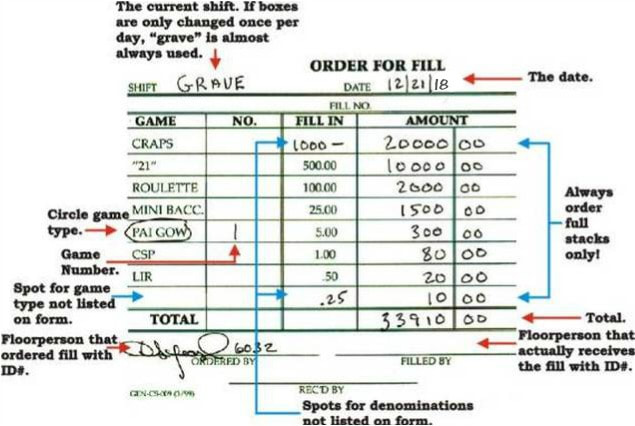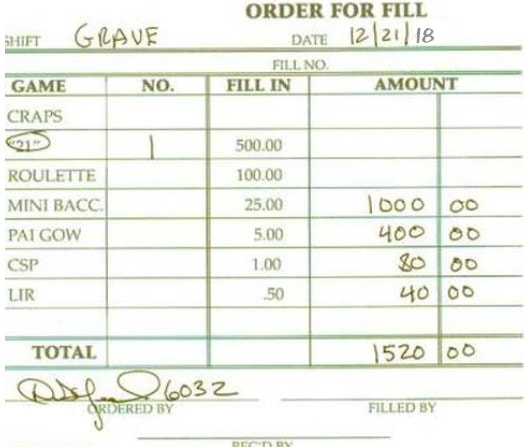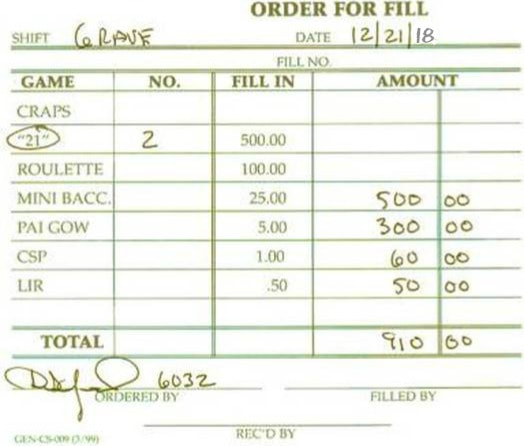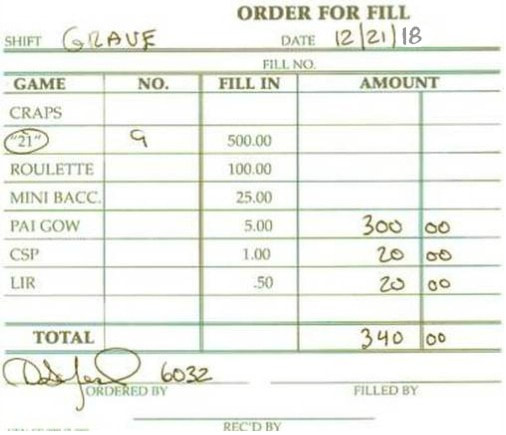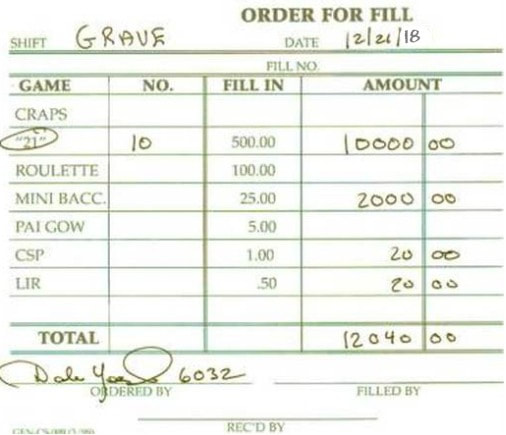Chapter 3
Fills And Credits
Understanding the count, the shift change and rolling the shift.
As you know, there are three shifts in a casino’s twenty-four hour day: grave, days and swing. Under the traditional system, the outgoing and incoming shift bosses "take the count" three times a day, at the shift change. As the shift bosses move from game to game, security guards follow them and change the drop boxes on each table game. The incoming shift boss completes the "master log" which, when completed, will have the "opening" amounts for all games on his shift.
The outgoing shift boss will complete the "brownie" which lists the individual amounts by denomination and the total "closing" amount of the game and will be dropped in the outgoing shift’s drop box. The outgoing shift boss will then accompany the cart containing the drop boxes to the cage and turn in a copy of the master log and a copy of the brownie for each game. The new trend for shift change involves the same procedures, except that the drop boxes are only changed once a day: during the change from swing to grave shifts.
Besides attempting to maintain game protection during this vulnerable period of the day, a floorperson has three main responsibilities during the count:
1.) To complete a new sweat sheet for the incoming shift and turn in the sweat sheet for the outgoing shift. This was discussed in the last chapter.
2.) To close out player’s rating cards for the outgoing shift and start new rating cards for the incoming shift. This will be discussed more thoroughly in the next chapter.
3.) To avoid doing table fills after the outgoing shift boss has totaled the old master log, which is usually thirty to sixty minutes before the count and to avoid doing fills after the count until the cage has had a change to "roll" the shift. Rolling the shift involves entering the closing amounts for the outgoing shift, for each game. Those amounts then become the opening amount for the incoming shift.
The timing of your fills is important.
This last point becomes the first guide to when to do table fills: don’t do fills unless absolutely necessary in the last hour of the shift and don’t do fills in the beginning of a shift until the cage has had a chance to roll. Sometimes, it is impossible to follow these guidelines. Events, such as a big player choosing to buy-in for five-thousand dollars on a five dollar minimum game will necessitate you making a call to your pit or shift boss and informing him that you need to do an "emergency fill" for that game.
What you don’t want is for laziness or bad planning on your part to be the reason that an emergency fill is needed. You also don’t want to order your fills piece meal, ordering one or two fills at time, which causes security to be making too many trips to the fill bank at the cage. The strategy most floorpersons seem to discover on their own is to fill all tables in their section as soon after possible as the new shift rolls. Unless of course they aren’t needed, then it is better to wait until the conditions of the racks justify it. And to fill all of their games towards the end of their shift, so the games are ready for the shift change and so your relief will have ample checks when he takes over your section. The cardinal sin for a floorperson is to run out of checks on a game. If you have a big player, you need to make sure you keep enough checks on the game to insure you will be able to withstand a protracted winning streak. If you do run out of checks, all you can do is stop the game and order an emergency fill.
Completing an "order for fill" form.
The "order for fill" (or "request for fill") forms are either kept on the podium or bound together in a book. There is almost always a top (white) copy and a carbon (yellow) copy. When using order for fill slips that aren’t bound together it is sometimes easier if you use a clipboard, however you don’t want to write on a form with other forms under it, as your writing will show up on the carbons of the forms beneath it. If completing an order for fill form that is contained in a book, make sure you have the cardboard cover inserted under the yellow copy of the form you are writing on
.
Your supervisors will be expecting you to follow one of the two possible guidelines for ordering fills. The first and probably least common is that the total of a fill must be in increments of one thousand dollars. If this is the case, you will need to start with the smallest denomination first. E.g., I want to order $20 is halves, so I order $80 in ones, so it is an even one hundred. I then need to plan on ordering either $900 in red or $400 in red and $500 in green, so it will total an even $1000. If you are expected to use this method it is because the pit manager wants to be able to record your fill on the master log as 1.0 as apposed to 1010 and have the total of the fills on the master log match exactly the total amount the cage says were done.
The second and more common guideline is only order checks in full stacks. This is done to make the job of preparing the fills easier for the person working the fill bank in the cage and to reduce the chances of them making a mistake. It is this guideline I will be using in the examples presented in this chapter.
When completing an order for fill form, I always enter the peripheral information (shift, date, game type and number and my signature first so I am unlikely to forget them. While few pit managers expect your signature to be legible, your employee number must be, so someone can figure out who signed the form.
As you know, there are three shifts in a casino’s twenty-four hour day: grave, days and swing. Under the traditional system, the outgoing and incoming shift bosses "take the count" three times a day, at the shift change. As the shift bosses move from game to game, security guards follow them and change the drop boxes on each table game. The incoming shift boss completes the "master log" which, when completed, will have the "opening" amounts for all games on his shift.
The outgoing shift boss will complete the "brownie" which lists the individual amounts by denomination and the total "closing" amount of the game and will be dropped in the outgoing shift’s drop box. The outgoing shift boss will then accompany the cart containing the drop boxes to the cage and turn in a copy of the master log and a copy of the brownie for each game. The new trend for shift change involves the same procedures, except that the drop boxes are only changed once a day: during the change from swing to grave shifts.
Besides attempting to maintain game protection during this vulnerable period of the day, a floorperson has three main responsibilities during the count:
1.) To complete a new sweat sheet for the incoming shift and turn in the sweat sheet for the outgoing shift. This was discussed in the last chapter.
2.) To close out player’s rating cards for the outgoing shift and start new rating cards for the incoming shift. This will be discussed more thoroughly in the next chapter.
3.) To avoid doing table fills after the outgoing shift boss has totaled the old master log, which is usually thirty to sixty minutes before the count and to avoid doing fills after the count until the cage has had a change to "roll" the shift. Rolling the shift involves entering the closing amounts for the outgoing shift, for each game. Those amounts then become the opening amount for the incoming shift.
The timing of your fills is important.
This last point becomes the first guide to when to do table fills: don’t do fills unless absolutely necessary in the last hour of the shift and don’t do fills in the beginning of a shift until the cage has had a chance to roll. Sometimes, it is impossible to follow these guidelines. Events, such as a big player choosing to buy-in for five-thousand dollars on a five dollar minimum game will necessitate you making a call to your pit or shift boss and informing him that you need to do an "emergency fill" for that game.
What you don’t want is for laziness or bad planning on your part to be the reason that an emergency fill is needed. You also don’t want to order your fills piece meal, ordering one or two fills at time, which causes security to be making too many trips to the fill bank at the cage. The strategy most floorpersons seem to discover on their own is to fill all tables in their section as soon after possible as the new shift rolls. Unless of course they aren’t needed, then it is better to wait until the conditions of the racks justify it. And to fill all of their games towards the end of their shift, so the games are ready for the shift change and so your relief will have ample checks when he takes over your section. The cardinal sin for a floorperson is to run out of checks on a game. If you have a big player, you need to make sure you keep enough checks on the game to insure you will be able to withstand a protracted winning streak. If you do run out of checks, all you can do is stop the game and order an emergency fill.
Completing an "order for fill" form.
The "order for fill" (or "request for fill") forms are either kept on the podium or bound together in a book. There is almost always a top (white) copy and a carbon (yellow) copy. When using order for fill slips that aren’t bound together it is sometimes easier if you use a clipboard, however you don’t want to write on a form with other forms under it, as your writing will show up on the carbons of the forms beneath it. If completing an order for fill form that is contained in a book, make sure you have the cardboard cover inserted under the yellow copy of the form you are writing on
.
Your supervisors will be expecting you to follow one of the two possible guidelines for ordering fills. The first and probably least common is that the total of a fill must be in increments of one thousand dollars. If this is the case, you will need to start with the smallest denomination first. E.g., I want to order $20 is halves, so I order $80 in ones, so it is an even one hundred. I then need to plan on ordering either $900 in red or $400 in red and $500 in green, so it will total an even $1000. If you are expected to use this method it is because the pit manager wants to be able to record your fill on the master log as 1.0 as apposed to 1010 and have the total of the fills on the master log match exactly the total amount the cage says were done.
The second and more common guideline is only order checks in full stacks. This is done to make the job of preparing the fills easier for the person working the fill bank in the cage and to reduce the chances of them making a mistake. It is this guideline I will be using in the examples presented in this chapter.
When completing an order for fill form, I always enter the peripheral information (shift, date, game type and number and my signature first so I am unlikely to forget them. While few pit managers expect your signature to be legible, your employee number must be, so someone can figure out who signed the form.
Let’s get busy!
So the pit boss has informed me that the shift has rolled and I can do fills if I want to. I will still be using the examples of BJ’s 1, 2, 9 and 10 that were used in Chapter 2. When I ran down those games I knew of at least two games that I wanted to fill so I will take my sweat sheet, my black ink pen, a pencil and the fill book that contains the "request for fills" forms. The general procedure begins with checking my sweat sheet to insure it’s accuracy. Then checking my rack and deciding how much it needs and then subtracting whatever checks are on the layout (or I know a player has gone south with) because I want have room in the rack if the players lose those checks or colors up.
So the pit boss has informed me that the shift has rolled and I can do fills if I want to. I will still be using the examples of BJ’s 1, 2, 9 and 10 that were used in Chapter 2. When I ran down those games I knew of at least two games that I wanted to fill so I will take my sweat sheet, my black ink pen, a pencil and the fill book that contains the "request for fills" forms. The general procedure begins with checking my sweat sheet to insure it’s accuracy. Then checking my rack and deciding how much it needs and then subtracting whatever checks are on the layout (or I know a player has gone south with) because I want have room in the rack if the players lose those checks or colors up.
As much as I would like to get the blacks to three stacks, the six checks are enough to prevent me from ordering a stack. If there were only four or five extra black, I would definitely order a stack. I will order one thousand in green so I will be at twenty four hundred. I never order to achieve two full tubes of green, since I want to be able to absorb a couple of hundred without the necessity of utilizing the empty tube I always leave myself with.
I leave myself an empty tube so the dealer will have a place to put barber pole losing bets prior to cleaning them and so he has a place to accommodate at least three stacks of checks a player might come up to the table with and lose.
Ordering four hundred in red will get me where I want to be. Each tube of the rack will hold eighty dollars worth of dollars or halves. I want to get the silver as close to the top as possible, without going over. In this case, I will order eighty in dollars and forty in halves. Always make sure you fill the silver up when filling a game. Nothing demonstrates incompetence better than a table being short on silver after a fill is done!
I complete the fill slip as shown below, and then time-stamp the back of the yellow copy and leave both copies near the paddle. If this casino’s procedures don’t call for either copy of the request for fill to be dropped when the fill arrives, some floorpersons will sign the "filled by" section of the form and leave just the white copy on the game and leave the yellow copy on the podium.
I leave myself an empty tube so the dealer will have a place to put barber pole losing bets prior to cleaning them and so he has a place to accommodate at least three stacks of checks a player might come up to the table with and lose.
Ordering four hundred in red will get me where I want to be. Each tube of the rack will hold eighty dollars worth of dollars or halves. I want to get the silver as close to the top as possible, without going over. In this case, I will order eighty in dollars and forty in halves. Always make sure you fill the silver up when filling a game. Nothing demonstrates incompetence better than a table being short on silver after a fill is done!
I complete the fill slip as shown below, and then time-stamp the back of the yellow copy and leave both copies near the paddle. If this casino’s procedures don’t call for either copy of the request for fill to be dropped when the fill arrives, some floorpersons will sign the "filled by" section of the form and leave just the white copy on the game and leave the yellow copy on the podium.
If this game were dead I would order five hundred green, four hundred red, sixty in dollars and fifty in halves. Remember, my one player on this game has one hundred black, one fifty in green and one hundred red. The player’s black and green won’t affect my ordering decision. However, I will mentally subtract the player’s one hundred red from the four hundred red I need to complete the rack.
Remember that I have two players on this game that at the moment have a total of six hundred green. So I will order three hundred in red, twenty in dollars and twenty in halves.
BJ-10 is a twenty-five dollar minimum game and I won’t fill it the way I would a five-dollar minimum. I will only fill up to two full tubes of red and in some houses, I would only fill up to one tube of dollars, especially if the game is subject to having one thousand dollar checks on it. The player still has ten thousand purple and seventeen hundred black. I don’t like to keep more than one tube of purple but I will order a stack of purple because I am counting on one of three things happening. Either the player will quit with the checks he has now and color up his black, in which case I will have the black and purple the way I want it. Or he will lose everything and in the case of this unlikely miracle, I won’t mind either having an extra stack of purple or doing a credit. Or he will continue his winning streak and I might well need another stack of purple. The green in the toke box certainly won’t be coming back so I will order two thousand green. Twenty in dollars and twenty in halves will complete this fill.
Final tasks to complete before your fills arrive.
You will now insure that you have time-stamped the back of the yellow copies of the fill slip and return it to the game so it can be signed with the original when the fill arrives. That is unless you aren’t required to drop a copy of the order for fill with the fill slip that comes with your fill and you took the liberty of pre-signing the “Rec’d by” box. In this case you will put the yellow copy in the designated place on the podium and leave the white copy on the game.
Some floorpersons will take this opportunity to add the fills to the sweat sheet or table card and expect you (if you are his relief) to work around the numbers until the fills actually arrive. This isn’t that difficult. The presence of the white copy of the game should tip you off to the fact that a fill is on its way and you merely have to mentally subtract the amounts on the slip if you are checking the sweat sheet to close out a rating card.
You might be required to call security or cage to let them know you have fills ordered.
Receiving your fills.
When security arrives with the fills, it is polite to allow him to decide which games he wants to start with. However, there are some circumstances that I will “take the lead” and decide to fill certain games first. It might be a table that is running low on checks, or a dead game that is better to fill first before a player arrives or a game where the dealer has just finished a hand or shuffle.
The security officer will hand you the fill slip from the cage and you will check it for game number, date and insure it was time stamped. The officer will then set the racks on the layout and the dealer will prove the amounts. You should check it against your order for fill form even though if it doesn’t match, you might accept the fill anyway and fill out a new order for fill form to match the fill slip from the cage.
If everything checks out, you sign the slip and have the dealer check the slip and sign it. Make sure both you and the dealer put your employee number legibly if it is required. Then dealer will now fill the rack. If you haven’t yet added the total of the fill and the individual amounts to the sweat sheet, now is the time to do it. Don’t make the guard wait for the dealer to unwrap silver. Have the dealer put the rolls of silver in the rack, then drop the slip. Stay at the table during this process.
If the fill is wrong then you have the guard take the fill back to the cage and then notify your pit manager,
If you are required to drop a copy of the request for fill, make sure you sign it. Then place the original in the designated place on the podium. If you aren’t required to drop the copy, you will put the copy on the podium and either discard the original or staple it to your sweat sheet.
Reasons for doing credits.
A credit is done to send excess checks from a table game to the cage. Some of the circumstances that can create this need are:
- Changing a layout or moving a game can necessitate sending the entire bankroll to the cage.
- To send smaller denomination checks to the cage to make room for larger denomination checks that have been ordered to accommodate a big player.
- To return purple checks or large amounts of black that was put on a low minimum game to accommodate a big player.
The procedure for doing credits.
If you need to credit and entire rack, you will:
1.) Call surveillance and notify them that you will be doing a credit and what game it is.
2.) Call security and or cage and tell them you are doing a credit, what game it is and how many check racks to bring.
3.) When security comes have the dealer prove the checks on the layout, including coins.
4.) Fill out the request for credit form, including signing the “ordered by” and “filled by” signatures
5.) Have security sign the “rec’d by” section of the request for credit.
6.) Time stamp the original.
7.) Either call surveillance again or have security radio them with the exact amount of the fill.
8.) Give security the original of the request for credit then take the copy to the computer and enter it.
9.) Indicate the credit on your sweat sheet and fill out a “zero” closing slip for that game.
10.) When security returns with the credit slip from the cage, check it for accuracy then have the dealer sign it and then you sign it. Then drop the slip in the drop box.
11.)Time stamp the back of the copy of the request for credit and put it on the podium with your fill slips.
Remember that credits can be done in whole dollar amounts only. If there is an extra halve or one, two or three extra quarters on the game, they will be dropped in the drop box. Also, remember that you will be so accustomed to entering “F” in the fill or credit screen, that is will be easy to forget to enter “C.”
If you need to send back a known amount of checks, such as ten thousand in purple, you will:
1.) Call surveillance and tell them you will be doing a credit, how much it is and what game it is.
2.) Fill out the request for credit and enter it in the computer.
3.) Time stamp both copies.
4.) Call security and or cage and tell them you are doing a credit, what game it is and how many racks they need to bring.
5.) Put both copies by the drop slot of the game.
6.) When security arrives have the dealer prove the checks on the layout and put it in the rack.
7.) Have security sign the request for credit.
8.) Give security the original of the request for credit.
9.) Indicate the credit on your sweat sheet or table card.
10.) When security returns with the credit slip, check it, sign it, have the dealer sign it and then have the dealer drop it.
11.) Put the copy of the request for fill with your fill slips on the podium.
If, when receiving a fill, you find that you don’t have enough room in the rack for all of the checks, you can call the eye and tell them you are doing a credit and putting the checks in a rack and setting them next to the float. You can them fill out a request for credit and give security their copy and enter it in the computer while security is on the way to the cage.
Adapt to the way your casino does things!
I hope that I have given a good overview of how fills and credits are done. Please don’t get overly hung-up on the details I have given. Things are done at least a little bit different from casino to casino. By comparing the procedures I have described to how things are done where you are working can give you insights to the common denominators of procedures everywhere.
Site created and designed by
Scott Cameron
Las Vegas, Nevada
Scott Cameron
Las Vegas, Nevada
Email me [email protected]
Copyright 2020-2024
Last update 3/18/2024
Last update 3/18/2024
Visit my other website...


